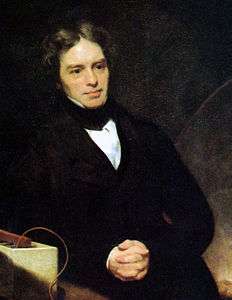Faraday's laws of electrolysis
Faraday's laws of electrolysis are quantitative relationships based on the electrochemical research published by Michael Faraday in 1833.[1][2] They state that the amount of material produced at an electrode (or liberated from it) during an electrochemical reaction is directly proportional to the total conducted charge or, equivalently, the average current multiplied by the total time.
First law
Michael Faraday reported that the quantity of elements separated by passing an electric current through a molten or dissolved salt is proportional to the quantity of electric charge passed through the circuit. This became the basis of the first law of electrolysis. The mass of the substance (m) deposited or liberated at an electrode is directly proportional to the quantity of electricity or charge (Q) passed.[3] In this equation k is equal to the electromechanical constant.
or
where; e is known as the electrochemical equivalent of the metal deposited or of the gas liberated at the electrode.
Second law
Faraday discovered that when the same amount of current is passed through different electrolytes/elements connected in series, the mass of substance liberated/deposited at the electrodes is directly proportional to their equivalent weight.
Mathematical form
Faraday's laws can be summarized by
where:
- m is the mass of the substance liberated at an electrode in grams
- Q is the total electric charge passed through the substance in coulombs
- F = 96,485.3321233100184 C mol−1 is the Faraday constant
- M is the molar mass of the substance in grams per mol
- z is the valency number of ions of the substance (electrons transferred per ion).
Note that M/z is the same as the equivalent weight of the substance altered.
For Faraday's first law, M, F, and z are constants, so that the larger the value of Q the larger m will be.
For Faraday's second law, Q, F, and z are constants, so that the larger the value of M/z (equivalent weight) the larger m will be.
In the simple case of constant-current electrolysis, leading to
and then to
where:
- n is the amount of substance ("number of moles") liberated: n = m/M
- t is the total time the constant current was applied.
For the case of an alloy whose constituents have different valencies, we have
where wi represents the mass fraction of the ith element.
In the more complicated case of a variable electric current, the total charge Q is the electric current I() integrated over time :
Here t is the total electrolysis time.[4]
References
- Faraday, Michael (1834). "On Electrical Decomposition". Philosophical Transactions of the Royal Society. 124: 77–122. doi:10.1098/rstl.1834.0008.
- Ehl, Rosemary Gene; Ihde, Aaron (1954). "Faraday's Electrochemical Laws and the Determination of Equivalent Weights". Journal of Chemical Education. 31 (May): 226–232. Bibcode:1954JChEd..31..226E. doi:10.1021/ed031p226.
- "Faraday's Laws of Electrolysis: Definition & Equation – Video & Lesson Transcript". Study.com. Retrieved 2018-12-10.
- For a similar treatment, see Strong, F. C. (1961). "Faraday's Laws in One Equation". Journal of Chemical Education. 38 (2): 98. Bibcode:1961JChEd..38...98S. doi:10.1021/ed038p98.
Further reading
- Serway, Moses, and Moyer, Modern Physics, third edition (2005), principles of physics.
